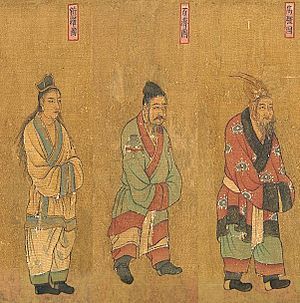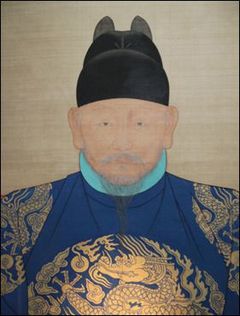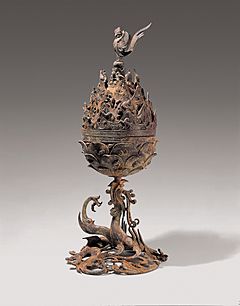History of Korea facts for kids
The history of Korea is a long and exciting journey, starting from ancient times and leading to the modern countries we know today. People have lived on the Korean Peninsula for a very long time, with the earliest signs of humans dating back about half a million years.
The first known Korean pottery appeared around 8000 BC. After 6000 BC, people started farming and living in settled communities, marking the Neolithic period. Later, around 2000 BC, people began using bronze, and by 700 BC, they were using iron. These early people, especially those from the Neolithic period, are thought to be the direct ancestors of today's Korean people.
Contents
Ancient Korea: Early Kingdoms and States
Gojoseon: Korea's First Kingdom
The first kingdom in Korea was called Gojoseon. It was located in northern Korea and southern Manchuria. Ancient stories, like those in the Samguk Yusa (written in the 1280s), say that Gojoseon was founded in 2333 BC by a legendary figure named Dangun. While this story is important for Korean identity, historians don't have proof of it.
The first written mention of Gojoseon is in a Chinese text called Guanzi. By the 4th century BC, Gojoseon was well-known in China, and its capital moved to Pyongyang.
For a long time, people believed that a Chinese prince named Gija founded a state called Gija Joseon in the 12th century BC. However, modern historians and archaeologists now think this story is not true.
In 194 BC, a Chinese refugee named Wi Man took control and established Wiman Joseon. This kingdom eventually fell to the Han dynasty of China in 108 BC. After Gojoseon fell, many smaller states appeared in the area.
Jin State and Chinese Influence
Around 300 BC, a state called Jin formed in the southern part of the Korean Peninsula. Not much is known about Jin, but it traded with China and Japan. Around 100 BC, Jin developed into three groups of states called the Samhan confederacies.
After the fall of Gojoseon, China set up four commanderies (areas controlled by China) in northern Korea in 108 BC. One of these, the Lelang Commandery, stayed for about 400 years, acting as a center for trade and culture with China.
Proto–Three Kingdoms: Many Small States
The time before the main Three Kingdoms of Korea is called the Proto–Three Kingdoms period. During this time, many small states grew out of the former Gojoseon territory. The largest and most important were Buyeo and Eastern Buyeo.
- Northern States:
* Buyeo existed from about the 2nd century BC to 494 AD in northern Korea and southern Manchuria. Its people were later absorbed into Goguryeo. * Okjeo and Dongye were smaller tribal states in the northern Korean Peninsula. They never became full kingdoms and were eventually taken over by the growing kingdom of Goguryeo.
- Southern States:
* The Samhan refers to three groups of states: Mahan, Jinhan, and Byeonhan. They were in the southern part of the Korean Peninsula. Mahan was the biggest. These states were eventually conquered by Baekje, Silla, and Gaya in the 4th century.
Three Kingdoms of Korea: Powerful Empires Emerge
The Three Kingdoms of Korea (57 BC–668 AD) were Goguryeo, Baekje, and Silla. These kingdoms grew to control the peninsula and parts of Manchuria.
Goguryeo: A Strong Northern Power

Goguryeo was founded in 37 BC by Jumong. It was the first Korean kingdom to make Buddhism its official religion in 372 AD. Goguryeo is also known as Goryeo, which is where the modern name "Korea" comes from.
Goguryeo was a very strong military state. It fought many wars with Chinese dynasties. In the 5th century, under Gwanggaeto the Great and his son Jangsu, Goguryeo became a powerful empire. It expanded into Manchuria, parts of Russia, and even took the city of Seoul from Baekje. Goguryeo defeated a huge Chinese army in the Goguryeo–Sui War, which even helped lead to the fall of the Sui dynasty in China.
In 668, after a long war and internal struggles, Goguryeo was finally conquered by an alliance of Silla and the Tang dynasty of China.
Baekje: A Maritime Kingdom
Baekje was founded in 18 BC by Onjo, a prince from Goguryeo. Baekje and Goguryeo shared similar founding stories. Baekje grew into a major power in the southwest of the peninsula.
At its peak in the 4th century, under King Geunchogo, Baekje controlled much of the western Korean Peninsula. Baekje was a great sea power. Its sailing skills helped spread Buddhism and Chinese culture to Japan. Many cultural ideas, like Chinese characters and advanced pottery, were brought to ancient Japan by Baekje.
Baekje was defeated by a combined force of Silla and Tang in 660 AD.
Silla: Unifying the Peninsula

The kingdom of Silla started in 57 BC in the southeastern part of Korea. Silla was the smallest and weakest of the Three Kingdoms at first. However, it was very smart in its diplomacy. Silla made alliances with other Korean kingdoms and eventually with Tang China.
In 660, Silla, with help from Tang forces, conquered Baekje. Then, in 668, they conquered Goguryeo. Silla then fought off the Tang forces to gain control over most of the Korean Peninsula by 676. This led to the Unified Silla period.
Gaya: A Confederacy of States
Gaya was a group of small kingdoms in the southern part of Korea, starting around 42 AD. The area was rich in iron, which helped them trade. Gaya was always fighting with the three larger kingdoms around it. It never became a unified state and was eventually absorbed into Silla in 562.
North and South States: A Time of Two Kingdoms
This period (698–926) refers to Unified Silla in the south and Balhae in the north. During this time, Korean culture and technology advanced greatly.
Unified Silla: A Golden Age
After uniting most of the Korean Peninsula, Unified Silla entered a golden age of art and culture. Buddhist temples like Bulguksa Temple and Seokguram Grotto were built, showing advanced Korean architecture. Silla also had strong trade links, even reaching the Middle East. Its capital, Gyeongju, was one of the largest cities in the world.
Buddhism was very important during this time. Many Korean Buddhist monks became famous in China. Unified Silla was a rich and successful country. However, political problems began in the late 8th century, weakening Silla. This led to new kingdoms forming, starting the Later Three Kingdoms period. Unified Silla lasted until 935.
Balhae: The Northern Kingdom

Balhae was founded in 698, just 30 years after Goguryeo fell. It was started by Dae Jo-yeong, a former Goguryeo general. Balhae controlled northern Korea, much of Manchuria, and parts of present-day Russia. It adopted some government ideas from China's Tang dynasty.
Balhae was a prosperous country, known as the "Prosperous Country in the East." However, it was conquered by the Khitan-led Liao dynasty in 926. Many refugees from Balhae, including the last crown prince, were welcomed by the new Goryeo dynasty in Korea.
Historians today study Balhae as an important part of Korean history, especially because it was a successor to Goguryeo.
Later Three Kingdoms: A Brief Return to Division
The Later Three Kingdoms period (892–936) saw Unified Silla decline and new kingdoms, Later Baekje and Later Goguryeo, rise up. Taxes were high, and rebellions broke out.
- Later Baekje was founded in 892 by General Gyeon Hwon.
- Later Goguryeo was founded in 901 by the monk Gung Ye. Its name was later changed to Majin and then Taebong.
In 918, a general named Wang Geon took power from Gung Ye and established the Goryeo dynasty. By 936, Goryeo conquered its rivals and unified the peninsula once more.
Goryeo Dynasty: A New Era of Unity
Goryeo was founded by Wang Geon in 918. He named it "Goryeo" to show it was a successor to the ancient Goguryeo. The capital was Kaesong. The Goryeo dynasty lasted until 1392. The name "Goryeo" is the origin of the English name "Korea."
During this period, laws were written down, and a system for government officials was introduced. Buddhism thrived, and beautiful celadon pottery was developed. Goryeo also made amazing cultural achievements, like creating the Tripitaka Koreana (Buddhist scriptures carved onto over 81,000 wooden blocks) and inventing metal movable type for printing.
In 1018, Goryeo defeated a powerful invasion by the Liao dynasty. After this victory, Goryeo experienced a golden age for about a century, with great progress in printing, publishing, and education.
In 1231, the Mongols began invading Korea. After decades of fighting, Goryeo eventually became influenced by the Mongol Empire and the Yuan dynasty of China for about 80 years. Korean kings married Mongol princesses, and a Korean woman even became the last empress of the Yuan dynasty.
In the 1350s, the Yuan dynasty weakened, allowing King Gongmin to reform the Goryeo government. Goryeo fought off more Mongol attempts to control them and also defeated Japanese pirates using new naval artillery.
The Goryeo dynasty ended in 1392 when General Yi Seong-gye took power in a coup.
Joseon Dynasty: A Long and Influential Period

In 1392, General Yi Seong-gye established the Joseon dynasty (1392–1897). He named it after the ancient kingdom of Gojoseon. The main philosophy of Joseon was Neo-Confucianism, which focused on morality and ethics.
Taejo moved the capital to Hanyang (modern-day Seoul) and built Gyeongbok Palace. He made Neo-Confucianism the official religion. His son and grandson, King Taejong and Sejong the Great, strengthened the royal power and made many reforms.
A Golden Age of Culture and Science
The 15th and 16th centuries were a golden age for Joseon, with many advancements in culture and science. The most important achievement was the creation of Hangul, the Korean alphabet, by Sejong the Great (reigned 1418–1450). This made reading and writing much easier for everyone. There were also great strides in printing, weather observation, astronomy, and military technology.
Challenges and Isolation
After nearly two centuries of peace, Joseon faced foreign invasions and internal problems from 1592 to 1637. The most significant were the Japanese invasions of Korea. Korea, with help from China's Ming dynasty, fought off these invasions. This war made Admiral Yi Sun-sin famous for his use of the turtle ship.
After the Japanese invasions, Joseon also had to repel invasions by the Manchus in 1627 and 1636. These wars made Koreans feel more united as a nation. After the Manchu invasions, Joseon had about 200 years of peace from outside threats. However, internal political fights continued.
In the 18th century, King Yeongjo and King Jeongjo led a new period of growth. They reformed the tax system, strengthened the military, and supported learning. Printing with movable metal type improved, and more books were published.
The 19th Century: Decline and Opening Up
In the 19th century, the Joseon government faced corruption and social unrest. Korea tried to stay isolated from other countries, earning the nickname "Hermit Kingdom." This was to protect itself from Western powers. However, Joseon was eventually forced to open its borders for trade.
The government tried to make reforms, but it was difficult. There was a lot of corruption, especially in taxes. This made life very hard for farmers. New ideas, like the Donghak religion, became popular among peasants. Donghak focused on social equality and Korean nationalism.
In 1866, France invaded Ganghwa Island after Korea persecuted Catholic missionaries, but the Korean army fought them off. Later, in 1871, the United States also had a military conflict with Korea on Ganghwa Island. Five years later, Korea signed a trade treaty with Japan, and in 1882, with the United States, ending centuries of isolation.
Japan, which was rapidly modernizing, defeated China in the First Sino-Japanese War (1894–1895). This forced China to give up its claims of influence over Korea. In 1895, the Japanese were involved in the murder of Empress Myeongseong, who had sought Russian help.
Modern History: Empire, Occupation, and Division
Korean Empire (1897–1910)
After the First Sino-Japanese War, Korea was no longer under China's influence. In 1897, Joseon was renamed the Korean Empire, and King Gojong became Emperor Gojong. The new empire wanted to become strong and independent. It tried to make reforms, strengthen the military, and develop trade.
However, Japan's influence grew stronger after it defeated Russia in the Russo-Japanese War (1904–1905). On November 17, 1905, Korea became a protectorate of Japan, meaning Japan controlled its foreign affairs. Emperor Gojong was forced to step down in 1907. In 1909, a Korean independence activist, An Jung-geun, assassinated a former Japanese official. This led Japan to ban all political groups and move towards taking over Korea completely.
Japanese Rule (1910–1945)
In 1910, the Empire of Japan officially took over Korea through the Japan–Korea Annexation Treaty. Many Koreans formed resistance groups to fight against Japanese rule.
Japan tried to suppress Korean culture and language. Economic policies were put in place mainly to benefit Japan. Transportation and communication networks were built to extract resources and use Korean labor. Many Korean cultural items were destroyed or taken to Japan.
After Emperor Gojong died in 1919, there were rumors of poisoning. This led to widespread independence rallies across the country on March 1, 1919, known as the March 1st Movement. The Japanese violently suppressed this movement.
The Provisional Government of the Republic of Korea was established in Shanghai, China, to coordinate resistance against Japanese rule. This government is seen as the rightful government of the Korean people between 1919 and 1948. Many Koreans also joined resistance groups in Manchuria and other countries.
Division and Korean War (1945–1953)

After World War II ended in 1945, the Allies divided Korea into two zones. The Soviet Union occupied the northern half, and the United States occupied the southern half, along the 38th parallel. This division was meant to be temporary.
However, the two powers could not agree on forming a single Korean government. In 1948, this led to the creation of two separate countries: the "Republic of Korea" (South Korea) in the south, supported by the US, and the "Democratic People's Republic of Korea" (North Korea) in the north, supported by the Soviets and China.
On June 25, 1950, the Korean War broke out when North Korea invaded South Korea. The war caused immense destruction and killed about 3 million people. It ended with a cease-fire in 1953, but no peace treaty was signed. Korea remained divided.
Modern Korea (1953–Present)
After the war, South Korea was initially ruled by strong governments, but it eventually became a democracy in 1987. South Korea's economy grew incredibly fast, a period known as the Miracle on the Han River. It transformed from a very poor country into a fully developed nation with a strong economy, especially in technology, shipbuilding, and car manufacturing. South Korean pop culture, known as the Korean Wave, has also become popular worldwide.
North Korea established a communist government with a hereditary leadership, starting with Kim Il Sung. After the Soviet Union collapsed in 1991, North Korea's economy declined sharply. It now relies heavily on international aid and trade with China.
On April 27, 2018, North and South Korea signed the Panmunjom Declaration, agreeing to work towards ending their conflict and reunifying Korea in the future.
See also
 In Spanish: Historia de Corea para niños
In Spanish: Historia de Corea para niños
- Korean influence on Japanese culture
- List of monarchs of Korea
- Military history of Korea
- National Treasure of South Korea
- Prehistoric Korea
- Timeline of Korean history
- Korean Reunification
Images for kids
-
Korean earthenware jar with comb pattern; made 4000 BC, Amsa-dong, Seoul, now in British Museum
-
Korean Bronze Age sword. Seoul, National Museum of Korea
-
The Four Commanderies of Han, established in the former territory of Gojoseon after the fall of Wiman Joseon.
-
Gold buckle of the Proto–Three Kingdoms period
-
The pagoda of Bunhwangsa temple, 634 AD, which once stood seven to nine stories in height, yet these collapsed to its current state of three stories
-
Balhae stele at the National Museum of Korea
-
Korean Embassy to Japan, 1655, attributed to Kano Toun Yasunobu; British Museum






















